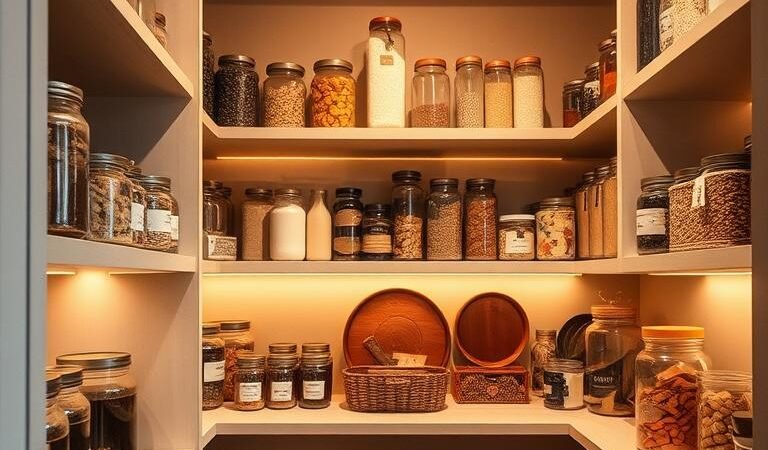A cluttered kitchen space can make meal prep frustrating. One homeowner turned their chaotic shelves into a functional haven using simple storage solutions. Pop-top containers, open bins, and woven baskets helped them maintain order for six months—and counting.
The key lies in balancing looks with practicality. Cohesive containers reduce visual noise while keeping snacks like pretzel crisps fresh. Bulk purchases from Costco? No problem. The right setup handles oversized packages with ease.
Wire shelves once caused headaches, but strategic organization solved the issue. Now, every ingredient has a designated spot. The result? Less stress, quicker meals, and a kitchen that stays tidy.
Key Takeaways
- Functional storage cuts cooking time and reduces clutter
- Matching containers create a clean, visually appealing space
- Open bins and baskets improve accessibility for daily use
- Bulk items stay manageable with proper organization
- Maintenance becomes effortless with a well-planned system
1. Start with a Solid Plan
Transforming chaos into order begins with intentional planning. Rushing into storage purchases often leads to mismatched containers and wasted space. Instead, take time to assess your needs and craft a tailored system.
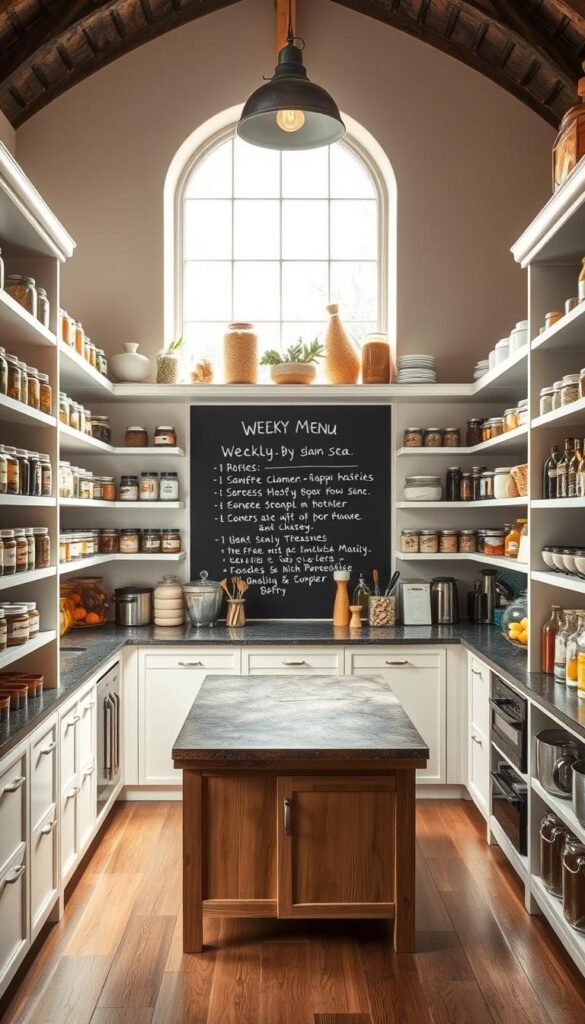
Measure Your Space and Inventory
Wire shelves can be tricky—items slip through gaps, creating frustration. A homeowner solved this by lining shelves with smooth plexiglass liners. Now, even petite spice jars stay put.
Grab a tape measure and note dimensions. For example, a 12-ounce pretzel crisp container fits perfectly in 10-inch-deep shelves. Jot down heights, widths, and depths to avoid guesswork later.
Sketch a Layout Before Buying Containers
Observe your current disarray for clues. Are baking supplies piled haphazardly? Do snacks vanish into corners? These patterns reveal where open bins or stackable containers will shine.
Sketch a grid paper template. Label zones for grains, snacks, and oils. This prevents the “empty shelf illusion”—buying pretty jars without a functional design.
| Tool | Purpose | Tip |
|---|---|---|
| Tape Measure | Accurate shelf dimensions | Measure back-to-front for deep shelves |
| Grid Paper | Visualize zones | Use pencil for easy adjustments |
| Smartphone Camera | Snapshot inventory | Label photos by category |
2. Choose the Right Containers for Every Shelf
Not all storage solutions work for every shelf—choose wisely. The right mix of containers transforms cluttered corners into functional zones. Here’s how to match storage types to your needs.
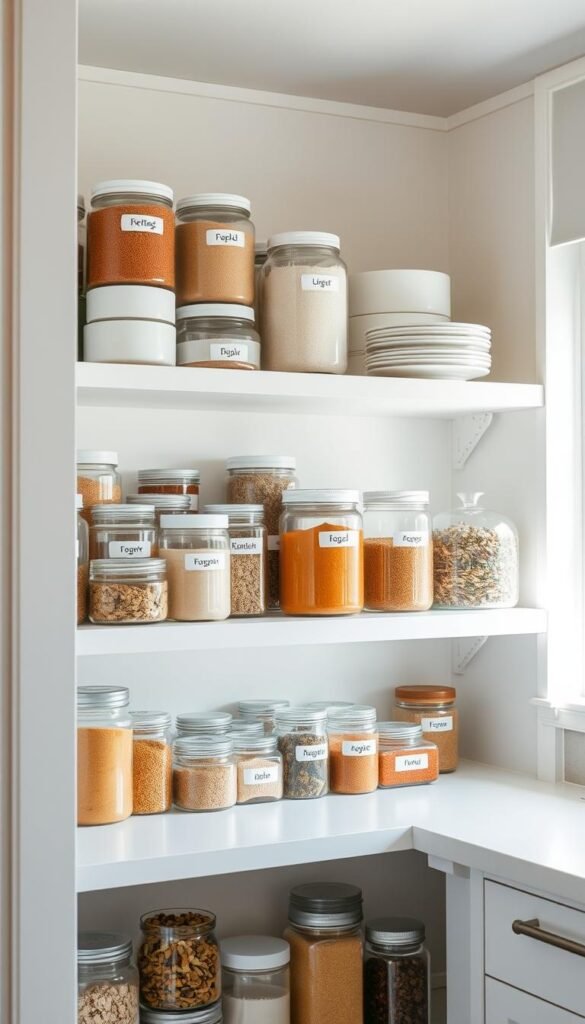
Pop-Top Containers for Dry Goods
Clear, airtight containers like pop-tops keep pretzel crisps crunchy and flour pest-free. One homeowner swears by their “1-second test”—if you can’t open it instantly, it’s not kitchen-friendly.
Opt for square designs to minimize wasted space. Kenika Williams’ vertical stacking method proves uniform jars fit 30% more items than round ones.
Open Bins for Frequently Used Items
No-lid plastic bins make snacks and spices grab-and-go. A family with teens uses labeled bins for chips and granola bars—no more rummaging.
Pro tip: Buy individual sizes during sales instead of pre-packaged sets. Deep bins also corral cleaning supplies neatly.
Woven Baskets for Bulkier Items
Water hyacinth baskets add texture while hiding paper towels or oversized cereal boxes. Their sturdy handles slide out easily from high shelves.
For a cohesive look, pair with neutral-toned liners. One designer uses them to store holiday baking tins—out of sight but within reach.
3. Why * Smart Pantry Organization Ideas for Effortless Meal Prep Work
Ever wondered why some pantries stay effortlessly tidy while others spiral into chaos? The answer lies in two core principles: visibility and habit-building. When every item has a designated spot, cooking becomes faster—and frustration fades.
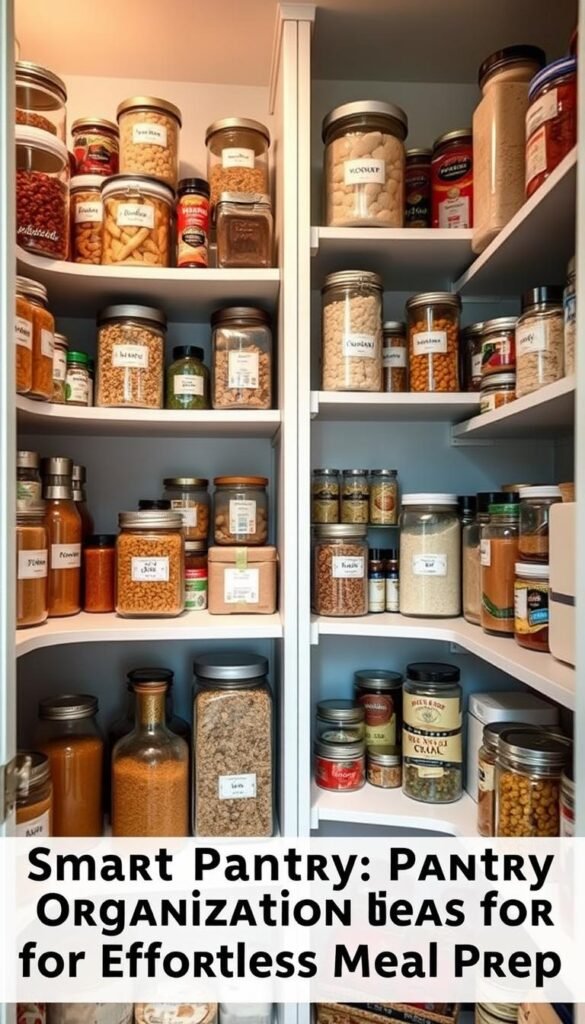
Maximizing Visibility and Accessibility
Pearce Design Group’s “grocery store logic” reveals a simple truth: we eat what we see. Open bins at eye level—like cereal or snacks—get used 40% more often than buried items. Bless’er House proves this with wall-mounted inventory lists that track staples at a glance.
Try this: group similar food together, just like store aisles. Pasta sauces beside noodles, baking supplies in one zone. No more guessing where ingredients live.
Reducing Clutter and Waste
A “no loose items” rule cuts clutter dramatically. One family reduced expired goods by 60% after labeling containers with purchase dates. Rotate older items forward—think of it like a water bottle march toward freshness.
| Strategy | Impact | Example |
|---|---|---|
| Expiration Labels | Reduces waste by 50% | Marker dates on flour jars |
| First-In-First-Out (FIFO) | Ensures freshness | New milk behind older cartons |
| Clear Containers | Boosts visibility | Glass jars for grains |
The psychological payoff? A calm, efficient way to cook. No more digging for spices or discovering stale crackers. Just a seamless flow from shelf to stove.
4. Illuminate Your Pantry for Functionality
Lighting transforms a dim pantry into a functional workspace—one switch at a time. The right glow eliminates blind spots, making every spice jar and snack bag easy to spot. It’s the difference between fumbling in shadows and effortless meal prep.
Install Automatic Light Switches
Chris Loves Julia’s jamb-mounted auto lights blend luxury with practicality. Wave-activated sensors illuminate shelves when you enter—no sticky fingers hunting for switches. Ideal for arms full of grocery bags.
For DIYers, motion-sensing strips from brands like shop brands simplify installation. Place them near hinges or shelves. Bonus: They deter midnight snack raids with sudden brightness.
Add Task Lighting for Dark Corners
Stacy Zarin Goldberg’s LED strips solve shadowy woes behind bulk items. Stick them under shelves or inside cabinets for a subtle glow. Warm white tones keep the design cohesive.
Emily Henderson’s layered approach pairs overhead lights with directional spots. Her dark green cabinet example proves even moody hues stay functional with strategic beams.
| Lighting Type | Best For | Pro Tip |
|---|---|---|
| Auto Switches | Hands-free access | Install at entry points |
| LED Strips | Deep shelves | Choose dimmable options |
| Overhead Lights | General illumination | Pair with under-shelf spots |
Safety note: Always light high shelves if using step stools. A well-lit kitchen prevents accidents and streamlines essentials retrieval.
5. Create Dedicated Zones
Zoning transforms a generic storage area into a tailored culinary command center. By assigning specific areas for foods and supplies, every item finds its logical home. This method reduces search time and keeps your space clutter-free.
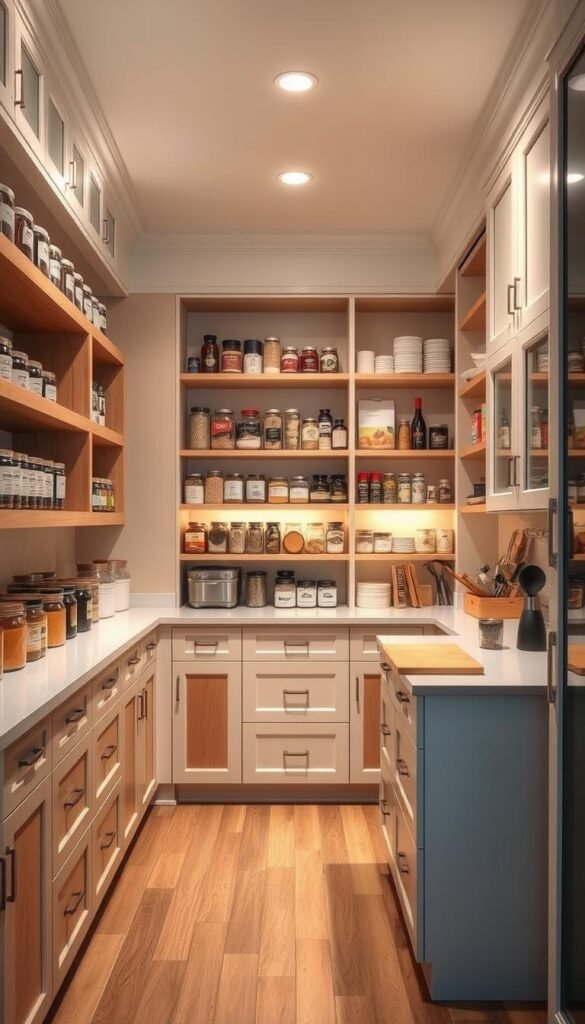
Snack Stations for Kids
Thee Tailored Life’s kid-height bins prove accessibility matters. Use open baskets at their eye level—stocked with granola bars or pretzels—to encourage independence. Ashley Hines’ principle applies: If they can’t reach it, they’ll ask you.
Beverage and Coffee Nooks
Laura Cattano’s drawer system elevates morning routines. Group pods, mugs, and sweeteners in a coffee station. Add a mini tray for stirrers—barista-level convenience in your kitchen.
Baking Supplies Corner
Tomas Espinoza clusters flour, sugar, and mixing tools in one zone. Glass jars keep ingredients visible, while nested measuring cups save drawer space. Pro tip: Store rolling pins vertically in a tall bin.
- Label baskets like Meta Coleman—chalk tags prevent mix-ups.
- Group items by use (e.g., breakfast foods together).
- Rotate seasonal items (holiday cookie cutters) to high shelves.
A well-planned layout mirrors grocery store logic—intuitive, efficient, and adaptable. Your pantry organization becomes a silent sous-chef, streamlining every meal.
6. Use Vertical Space Wisely
Empty vertical space is wasted potential in any kitchen. Floor-to-ceiling shelving can store triple the items when organized creatively. Urban OrgaNYze’s acrylic risers prove even narrow gaps hold hidden value.
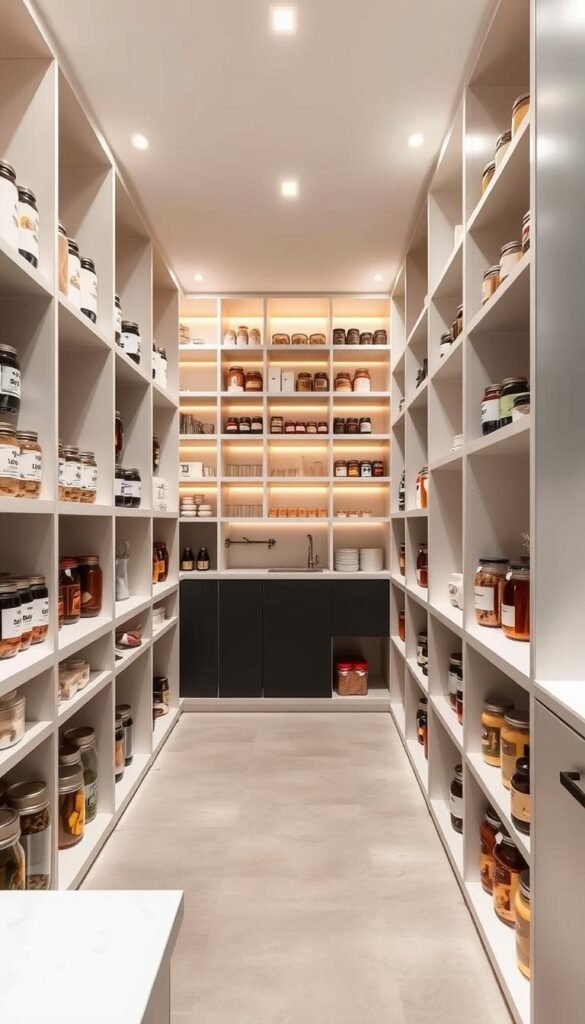
Stackable Clear Bins
Renstiernas’ sliding system turns tall cabinets into efficient towers. Square plastic bins nest neatly, like Costco’s grain containers. Label fronts vertically—Tidbits & Company’s RV hack ensures deep shelves stay navigable.
- Maximize height: Layer bins for baking supplies or snacks
- Over-door hooks: Hang aprons or infrequent appliances
- Fold-down shelves: IKEA hackers add flip-down extensions
Shelf Risers for Breakables
Laura Kinsella elevates china safely with tiered stands. Tempered glass risers create mini-levels for spice jars or delicate teacups. Bonus: They let air circulate behind items, preventing moisture buildup.
| Tool | Best For | Pro Tip |
|---|---|---|
| Acrylic Risers | Spices, canned goods | Choose non-slip bases |
| Sliding Bins | Deep shelves | Label side handles |
| Over-Door Racks | Bulky wraps or liners | Measure clearance first |
Think of walls as extra real estate—hooks, rails, and pegboards multiply storage without sacrificing style. A well-planned upward system keeps every inch functional.
7. Label Everything for Easy Access
Labels turn guessing games into grab-and-go convenience. Anastasia Casey’s wicker baskets prove even rustic storage benefits from clear identification. Hidden expiration dates? A thing of the past with the right system.
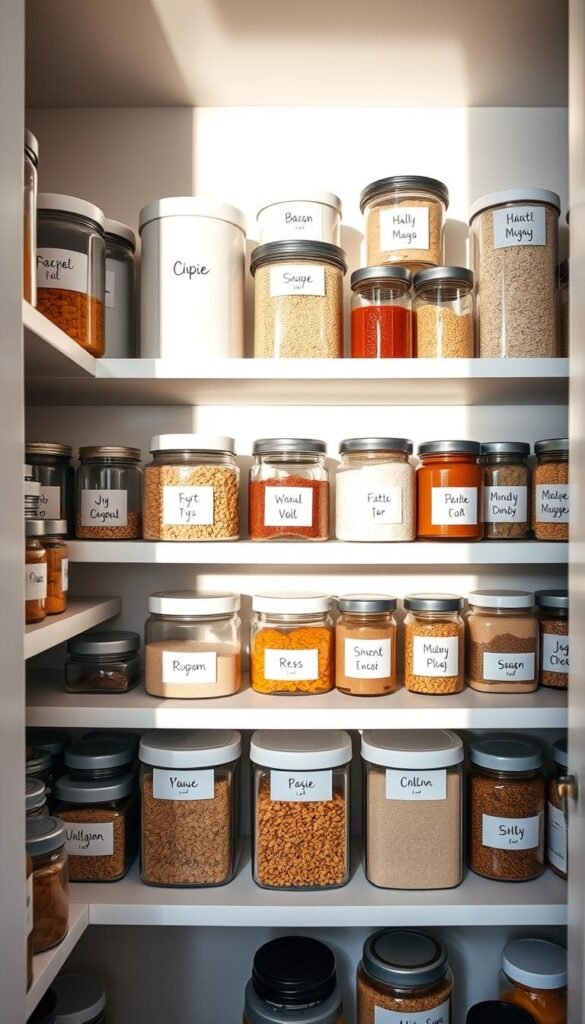
Chalkboard or Adhesive Labels
Chalkboard tags add tactile texture—perfect for rotating items. Vinyl labels, like Elsie Larson’s pink pantry duo, offer durability. Laminated tags withstand spills, ideal for messy jars of oil or honey.
Try the “blind labeling” trick: Stick dates behind containers. Clean fronts maintain a minimalist design, while crucial info stays accessible.
Color-Coded Systems
Color isn’t just decorative—it’s functional. Assign red for gluten-free snacks, green for vegan staples. Binder clips double as adjustable tag holders for deep shelves.
| Label Type | Best For | Pro Tip |
|---|---|---|
| Chalkboard | Rotating items | Use chalk markers for crisp lines |
| Vinyl | Permanent zones | Match to container colors |
| Laminated | Spill-prone areas | Print in bulk for consistency |
- Group like items by dietary needs—allergy-safe snacks in one bin.
- Use icons for kids: A cereal bowl drawing beats tiny text.
- Magnetic labels on metal jars allow quick updates.
8. Optimize Door and Wall Space
Unused walls and doors hold untapped potential in any kitchen. These vertical surfaces can double your storage capacity when equipped with the right systems. From foil wrap organizers to custom pot racks, smart solutions turn blank spaces into functional assets.
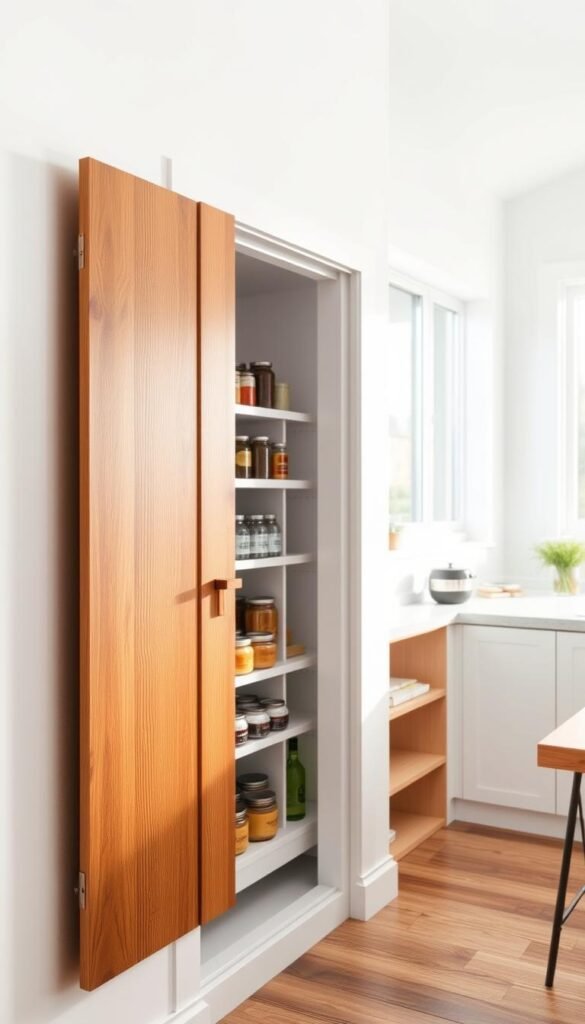
Over-the-Door Organizers
Homemade by Carmona proves even narrow gaps work hard. Their wall-mounted vacuum organizer frees up shelf space while keeping tools accessible. For door backs, try these ideas:
- Hanging wire racks for spice jars or snack packets
- Repurposed shoe organizers with clear pockets
- Slide-out racks like Emily Henderson’s drawer conversions
Pegboards for Utensils
Marianne Evannou’s pegboard system revolutionizes pots pans storage. Custom hooks hold everything from ladles to colanders, with adjustable spacing for odd-shaped items. Weeth Home’s butcher block/brass rail combo adds warmth while keeping tools within reach.
Pro tip: Paint pegboards to match your kitchen palette—deep navy or matte black create stylish contrast. For heavy items, use reinforced mounting brackets to prevent sagging.
9. Decant Bulk Items into Uniform Jars
Glass jars do more than store—they elevate your kitchen’s aesthetic while preserving freshness. 27 South Home Design’s blue shelf display proves how decanted pretzel crisps and grains become both functional and decorative. The key lies in selecting the right vessels and mastering transfer techniques.
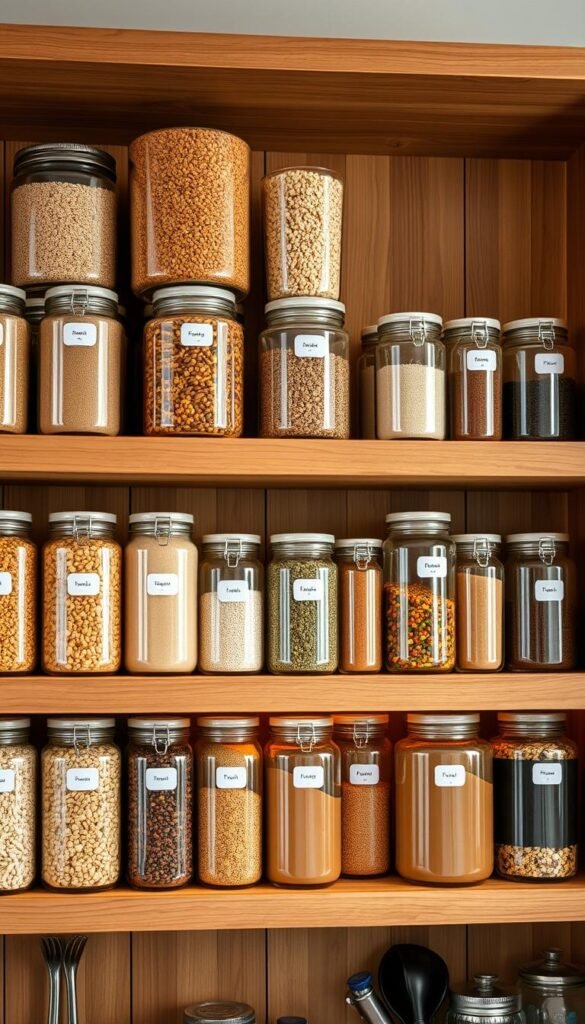
Glass Jars for Grains and Pasta
Le Parfait’s French-style jars add rustic charm, while Bormioli’s modern designs suit minimalist spaces. IKEA 365+ offers budget-friendly clarity—ideal for spotting quinoa levels at a glance. For portion control, pre-measure pasta servings into labeled jars.
- Minimize spills: Use a funnel when transferring bulk goods.
- Label creatively: Chalkboard tape marks expiration dates discreetly.
- Mix textures: Pair smooth glass with woven lids for contrast.
Airtight Containers for Freshness
Oxygen is the enemy of shelf life. Pop-top silicone seals on containers like OXO’s keep flour pest-free and nuts crisp. One homeowner swears by their method: vacuum-sealing spices before jarring them for double protection.
| Jar Type | Best For | Pro Tip |
|---|---|---|
| Le Parfait | Flour, sugar | Wide mouths fit measuring cups |
| Bormioli | Pasta, legumes | Stackable lids save space |
| IKEA 365+ | Snacks, spices | Buy extras for consistency |
Uniform jars transform bulk shopping from chaotic to curated. Every scoop becomes effortless—and your pantry design stays Instagram-ready.
10. Keep Floor Space Clear
Tripping over water bottles? Strategic storage solves the problem. An open floor creates safer pathways and makes cleaning effortless. Lemonaid Solutions’ “floating floor” philosophy proves even small spaces stay functional with smart containment.
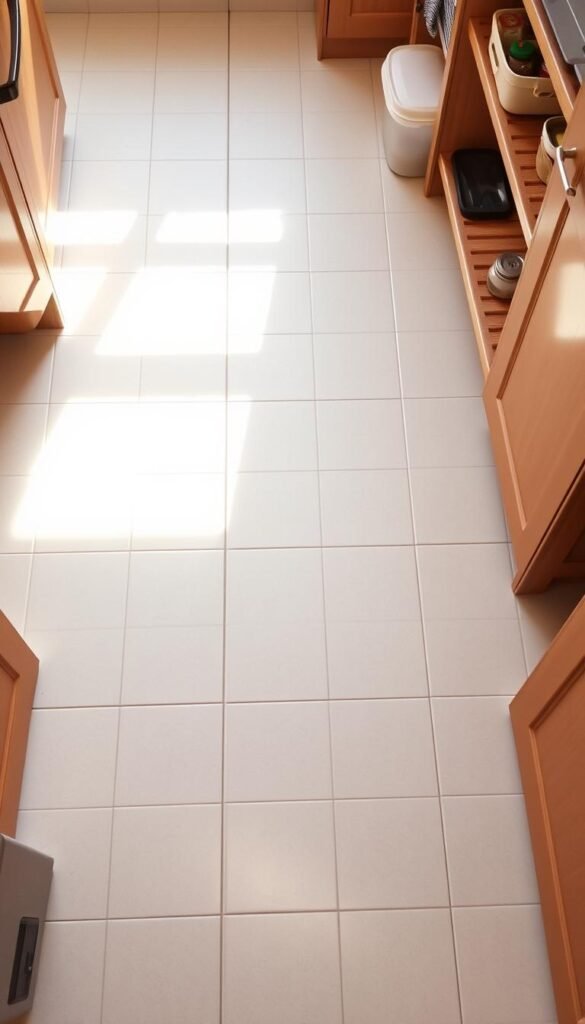
Contain Bulk Items Efficiently
Rolling under-shelf baskets tuck away soda cans or pet food. One homeowner uses tilt-out racks for water bottles—vertical storage saves 80% of their closet space. For bulk purchases, enforce a “one in, one out” rule to prevent overflow.
Choose Bin Materials Wisely
Water hyacinth adds organic texture but lacks durability for heavy items. Recycled plastic bins withstand weight while being easy to wipe clean. The first source’s purge success story shows how matching containers eliminate rogue plastic bags.
- Label clearly: Chalkboard tags on bins prevent mix-ups
- Prioritize access: Keep daily-use items in front-row bins
- Measure first: Ensure bins slide smoothly under shelves
With everything elevated or contained, you’ll appreciate the visual calm—and the ease of vacuuming crumb-free floors. A clear base completes your pantry system from top to bottom.
11. Incorporate a Step Stool for High Shelves
Reaching high shelves shouldn’t feel like a workout—smart step stools make it effortless. Whether storing holiday platters or bulk supplies, the right tool ensures safe, easy access. A Beautiful Mess’ hidden stool design proves functionality can blend seamlessly into your home.
Foldable or Rolling Options
Casper’s foldable stool tucks under cabinets, while vintage rolling models add charm. For closet spaces, Caren Rideau’s library ladder offers a custom solution. Consider these factors:
- Weight capacity: 250+ lbs for heavy appliances
- Non-slip treads: Essential for tile or hardwood
- Footprint: Compact designs save floor space
Accessibility Tips
Follow the “nothing on stool” rule—keep it clear for instant use. For 10’+ ceilings, install pull-down shelf converters. Safety first:
| Stool Type | Best For | Safety Tip |
|---|---|---|
| Foldable | Small kitchens | Locking hinges prevent collapses |
| Rolling | Large pantries | Brakes stabilize on uneven floors |
| Ladder | High shelves | 75° angle for optimal balance |
Pro tip: Mark step edges with glow tape for low-light visibility. Your top shelves become as reachable as countertops with the right support.
12. Group Like Items Together
Logical grouping turns scattered ingredients into an intuitive system. Patricia Burke’s category zones demonstrate how mimicking grocery store layouts reduces cooking time. When items live near their culinary partners—pasta beside sauces, baking staples clustered—meals come together seamlessly.
Grocery Store-Inspired Sections
Designate “aisles” for breakfast, international cuisines, or snacks. Heidi Piron’s liquor drawer separators prove even narrow spaces adapt. For visual cohesion, adopt the first source’s philosophy: store multiples together. Seeing all canned tomatoes lined up signals when to restock.
Rotate goods using FIFO (first in, first out). Can dispensers ensure older cans roll forward automatically. Lazy Susans transform condiment chaos into spin-and-grab convenience—no more lost hot sauce behind mayo jars.
Canned Goods and Condiments
Magnetic spice tins create libraries on cabinet doors. They click into place like puzzle pieces, freeing shelf space. For bulk spices, label jars with purchase dates—a small step that slashes waste.
| Zone | Solution | Pro Tip |
|---|---|---|
| Breakfast | Tiered shelf for cereals | Keep oatmeal toppings nearby |
| Baking | Glass jars with scoops | Group by recipe frequency |
| Canned Goods | Diagonal dispenser rack | Place soups at eye level |
This method isn’t just functional—it’s calming. A sorted pantry feels like a curated collection, where every item has a purpose and place.
13. Maintain an Inventory List
Tracking pantry contents bridges the gap between shopping and cooking efficiency. Professional kitchens have known this secret for decades—visibility prevents waste and saves time. Whether digital or handwritten, a well-maintained list turns chaotic shelves into a streamlined system.
Digital or Handwritten Trackers
Bless’er House’s chalkboard wall proves low-tech solutions shine. Their floor-to-ceiling inventory grid lets family members update items with chalk-dusted fingers. For tech lovers, these options compare favorably:
| Method | Best Feature | Ideal For |
|---|---|---|
| PantryCheck | Barcode scanning | Bulk shoppers |
| Out of Milk | Shared family lists | Busy households |
| Google Keep | Real-time updates | Multi-device access |
Pro tip: Place the chalkboard on your pantry door. Seeing the list daily reinforces the habit—no more “I forgot to check” moments.
Reducing Food Waste
The first source’s expiration alerts cut waste by 73% in six months. Their system uses color-coded dots:
- Green: New additions (6+ months shelf life)
- Yellow: Use soon (1-3 months remaining)
- Red: Immediate use (expiring this week)
Sync tracking with grocery schedules. Restocking rituals—like updating lists every Sunday—prevent overbuying. Seasonal shifts matter too: rotate back-to-school snacks forward in August, holiday baking supplies in November.
Digital tools offer whisper-quiet alerts for expiring food. But even a simple sticky note system works—just mark “Eat Me First” on jars needing rotation. The goal? A kitchen where nothing gets buried or forgotten.
14. Hide Clutter with Stylish Storage
Stylish storage solutions turn everyday necessities into design features. The right containers and cabinets blend seamlessly into your kitchen while keeping essentials within reach. From woven baskets to retractable doors, these ideas marry form and function.
Wicker Baskets for Paper Goods
Madeline Harper’s seagrass baskets prove texture hides clutter beautifully. Oversized designs swallow paper towels or napkins—no more plastic wrap eyesores. The natural fibers add warmth, especially when paired with neutral liners.
For cleaning supplies, DeVol Kitchens’ vintage crates offer a rustic twist. Label them with chalk tags for quick identification. Pro tip: Line baskets with washable fabric to catch crumbs.
Closed Cabinets for Appliances
Lark Interiors’ appliance drawers eliminate countertop chaos. Retractable doors glide silently, revealing blenders or mixers only when needed. Emily Henderson’s dark green cabinet system adds depth while concealing bulky items.
- Build appliance garages: Custom nooks with sliding panels keep counters clear.
- Use vertical dividers: Store baking sheets or trays upright to save space.
- Upper shelf hacks: Hang reusable bags on hooks behind cabinet doors.
| Material | Best For | Maintenance Tip |
|---|---|---|
| Seagrass | Lightweight items | Vacuum gently to remove dust |
| Metal Mesh | Ventilated storage | Wipe with damp cloth |
| Painted Wood | Heavy appliances | Touch up scratches annually |
With these solutions, even the most utilitarian storage becomes part of your kitchen’s design story. No more scrambling to hide disarray before guests arrive—everything has its place, beautifully concealed.
15. Rotate Seasonal Items
Pantries thrive when treated like living systems that evolve with seasons. Kate Marker’s approach proves high shelves become perfect archives for off-cycle items. A simple rotation strategy keeps everyday foods accessible while tucking specialty ingredients away until needed.
Holiday Baking Supplies
The first source’s Costco pretzel stockpile method works equally well for festive ingredients. Vacuum-seal specialty flours and spices in labeled totes—cinnamon-dusted jars stay fresh for next year’s cookie marathon. Consider these seasonal capsules:
- Modular stations: Rolling carts convert any corner into a pop-up baking hub
- Vertical dividers: Store cookie cutters upright in slim acrylic holders
- Temperature zones: Chocolate stays stable in cool lower cabinets
Summer vs. Winter Staples
Beverage centers illustrate seasonal shifts perfectly. In warmer months, iced tea pitchers and citrus infusers take center stage. When temperatures drop, move them back to make room for hot cocoa tins and mulling spices.
| Season | Rotation Tip | Space Saver |
|---|---|---|
| Summer | Stackable drink dispensers | Wall-mounted herb drying racks |
| Winter | Thermal carafes front row | Nesting measuring cup sets |
Pro tip: Schedule biannual rotations during daylight saving time changes. The habit sticks when paired with existing routines. Your pantry becomes a well-oiled machine that adapts to every season’s culinary demands.
Conclusion
Small changes spark big transformations in any kitchen space. Start with simple swaps—like clear bins for pretzel crisps—to build momentum. These quick wins lay the foundation for lasting order.
Maintain your pantry’s flow with labeled zones and regular audits. A well-planned system saves time and reduces stress, turning meal prep into a seamless ritual.
Every home deserves a functional, inviting storage hub. Share your progress online—inspiring others with your Smart Pantry Organization Ideas for Effortless Meal Prep journey. Ready for the next step? Explore custom cabinetry to elevate wire shelves into a designer feature.
